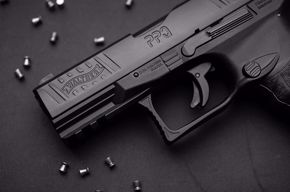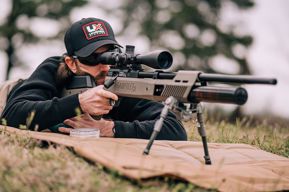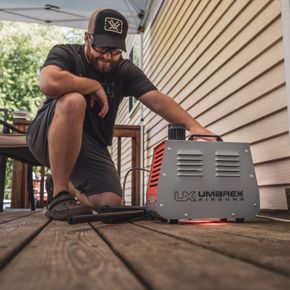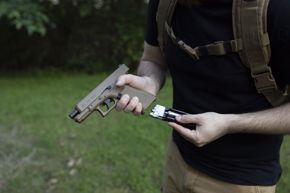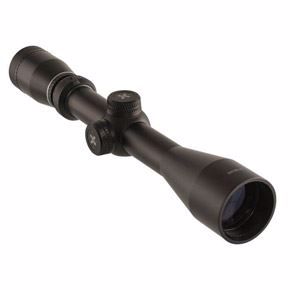How do you like to measure power? For me it depends on what you are talking about. If we are talking about lightbulbs, watts or watt equivalent will let me know how much light output to expect from that bulb. If it is an internal combustion engine, then horsepower and torque help tell the story for me. But when it comes to guns, from firearms to airguns, there are two common ways to describe power output and, depending on where you are from, one might be more common than the other.
For triggered devices we must return to some simple high-school physics for guidance. The crucial bits of information used for calculating a projectile's power will be a function of the weight of the projectile and how fast it is moving. Yes, there are some additional factors that will affect this downrange like the ballistic coefficient and gravity, but for right out of the muzzle, we really don’t need to concern ourselves with this just yet.
The Boring Part in the Middle
There are two primary ways of talking about muzzle energy, via Ft. Lbs, and Joules. When it comes to airguns, the reality is the easiest piece of information to attain for it is the velocity that is claimed on the box. While velocity does tell you part of the story it doesn’t tell you all of the story. The crucial missing factor is, “How much did the projectile weigh that was used to attain that velocity?” Once we have that piece of data we can plug both pieces of information into a muzzle energy calculator and get an idea of how much power is actually being produced.
The metric equation for muzzle energy looks like this: Kinetic Energy. = 1/2 m V2. The “m” is mass in kilograms and the “v” is velocity in meters per second. Using the calculator function on your phone, you can plug in the mass and velocity in metric units and learn how many Joules a projectile generates. Do be careful in converting the projectile’s weight into kilograms as one gram looks like this when written as a kilogram: 0.001. The formula to calculate energy in Joules is pretty simple, but this form is not used
In North America, well, the United States at least, we tend to gravitate toward the use of foot-pounds (Ft-Lbs). The Standard formula looks a little different but calculates a rating in foot-pounds (Ft-Lbs).That formula looks like this: E=M(g)∗BS2 /450,437
Energy = (Weight in grains x Velocity in feet per second squared) / 450,437).
How Do Joules and Ft.Lbs Compare?
Looking at the chart below, you can compare how one Ft. Lbs relate to Joules and how Joules compare to Ft. Lbs. While this doesn’t cover every possible comparison, it does give us enough information to see the relationship between the two.
|
Foot Pounds to Joules |
Joules to Foot Pounds |
|
1 = 1.36 |
1 = 0.74 |
|
2 = 2.71 |
2 = 1.48 |
|
4 = 5.42 |
4 = 2.95 |
|
8 = 10.85 |
8 = 5.9 |
|
10 = 13.56 |
10 = 7.38 |
|
12 = 16.27 |
12 = 8.85 |
|
20 = 27.12 |
20 = 14.75 |
|
25 = 33.9 |
25 = 18.44 |
|
30 = 40.67 |
30 = 22.13 |
|
40 = 54.23 |
40 = 29.5 |
|
50 = 67.8 |
50 = 36.88 |
|
75 = 101.7 |
75 = 55.32 |
|
100 = 135.58 |
100 = 73.76 |
|
150 = 203.37 |
150 = 110.63 |
|
200 = 271.16 |
200 = 147.51 |
|
300 = 406.75 |
300 = 221.27 |
|
400 = 542.33 |
400 = 295.02 |
|
500 = 677.9 |
500 = 368.78 |
|
600 = 816.5 |
600 = 442.54 |
|
700 = 949.07 |
700 = 516.29 |
|
800 = 1084.65 |
800 = 590.05 |
Lower powered air guns, those that make less than 7 Ft. Lbs or 10 Joules of energy are not suitable for small game hunting. We would recommend an airgun that produces at least 10 Ft. Lbs/14 Joules for small game hunting. Most break barrel air rifles in .177 caliber will make enough power for this task. The increasingly popular .22 caliber air rifle can produce muzzle energy well in excess of 10 Ft. Lbs of energy. Some can even be tuned to reach up into the 50-60 Ft Lbs or 68-82 Joules range. Hunting with an air rifle that can produce power in this higher range, between 20 and 60 Ft. Lbs/27 to 82 Joules can not only humanely harvest small game, but they can be used on predators like coyotes and foxes and feral pigs up to 50-60 lbs.
Some pellet guns in .30 caliber or larger can produce power in excess of 200 Ft. Lbs/270 Joules of energy at the muzzle. These airguns are good to use on hogs and predators but are generally not viewed as legal for harvesting deer or other larger species.
From this group of airgun calibers we move on to the big bores. Big bore air rifles, like the Umarex Hammer, a .50 caliber air rifle that produces 950 FPS and 650+ ft. lbs of energy with a 350 grain slug. This rifle has been used on legal white tail deer across the country as well as several exortic and dangerous game species in Texas and Africa.
Typically, big bore air rifles produce 300 or more Ft. Lbs of energy at the muzzle and shoot projectiles that weigh at least 150 grains in weight. In terms of Joules, a typical big bore air rifle will produce between 400 and 1080 Joules at the muzzle.
Here in the States, yes, we gravitate towards Ft. Lbs as a measure of power for all things pew related. However, when it comes to lower powered air gun products, many of these describe their power output in Joules. You might see a Joule power rating on an airsoft gun or paintball gun despite the US being firmly married to standard measurements.
What energy level is safe to use when hunting various species of game?
A feather going 3,000 feet per second is certainly moving remarkably fast for a feather but it isn’t carrying a lot of energy with it since it only weighs about the same as a small paper clip. On the flip side, a hippopotamus moving at 300 feet per second would knock a train engine clear off of a track. Forgive the crazy extreme examples but it does make the point. Roy Weatherby made his name in the firearms world by sending small caliber bullets much faster than the standard comparable calibers that were available to hunters in the 1950s through– well now.
Using a real world Weatherby Magnum to Standard Rifle caliber example, say in the .30 caliber range we can see just that. The .300 Weatherby Magnum with a 180 grain Barnes TTSX bullet is launching at 3,232 FPS while the .300 Winchester Magnum using the same bullet is traveling at 2,960 FPS, and the .30-’06 Winchester with the same bullet is moving at 2,700 FPS. The difference between the two magnum calibers is 270 FPS and just shy of 700 ft. lbs of energy. Then when you compare the Weatherby Magnum to the .30-’06, there’s a whopping 570 FPS and 1,280 Ft. Lbs advantage to the Weatherby.
In the firearms world, it is common to see various weights of projectiles and even some propellent tuning– essentially two readily adjusted factors that can help a shooter achieve the results they desire. With airguns, the projectile weight can easily be adjusted, but, often, the air “charge” behind the projectile is not so easily adjusted.
Airgunners tend to prize accuracy above all other factors and will trade off accuracy for a bit lower velocity. After all, close only counts in horseshoes and hand grenades. Or so they say.

